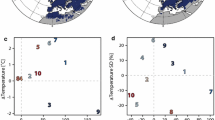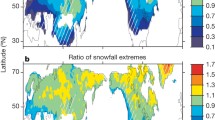Abstract
We investigate the response of a climate system model to two different methods for estimating snow cover fraction. In the control case, snow cover fraction changes gradually with snow depth; in the alternative scenarios (one with prescribed vegetation and one with dynamic vegetation), snow cover fraction initially increases with snow depth almost twice as fast as the control method. In cases where the vegetation was fixed (prescribed), the choice of snow cover parameterization resulted in a limited model response. Increased albedo associated with the high snow caused some moderate localized cooling (3–5°C), mostly at very high latitudes (>70°N) and during the spring season. During the other seasons, however, the cooling was not very extensive. With dynamic vegetation the change is much more dramatic. The initial increases in snow cover fraction with the new parameterization lead to a large-scale southward retreat of boreal vegetation, widespread cooling, and persistent snow cover over much of the boreal region during the boreal summer. Large cold anomalies of up to 15°C cover much of northern Eurasia and North America and the cooling is geographically extensive in the northern hemisphere extratropics, especially during the spring and summer seasons. This study demonstrates the potential for dynamic vegetation within climate models to be quite sensitive to modest forcing. This highlights the importance of dynamic vegetation, both as an amplifier of feedbacks in the climate system and as an essential consideration when implementing adjustments to existing model parameters and algorithms.









Similar content being viewed by others
References
Allen CD, Breshears DD (1998) Drought-induced shift of a forest-woodland ecotone: rapid landscape response to climate variation. Proc Natl Acad Sci 95:14839–14842
Bachelet D, Neilson RP, Hickler T, Drapek RJ, Lenihan JM, Sykes MT, Smith B, Sitch S, Thonicke K (2003) Simulating past and future dynamics of natural ecosystems in the United States. Global Biogeochem Cycles. doi:10.1029/2001GB001508
Barnett TP, Dumenil L, Schlese U, Roeckner E, Latif M (1989) The effect of Eurasian snow cover on regional and global climate variations. J Atmos Sci 46:661–686
Bonan GB, Levis S (2006) Evaluating aspects of the community land and atmosphere models (CLM3 and CAM3) using a dynamic global vegetation model. J Clim 19:2290–2301
Bonan GB, Pollard D, Thompson SL (1992) Effects of boreal forest vegetation on global climate. Nature 359:716–718
Bonan GB, Oleson KW, Vertenstein M, Levis S, Zeng X, Dai Y, Dickinson RE, Yang ZL (2002) The land surface climatology of the community land model coupled to the NCAR community climate model. J Clim 15:3123–3149
Breshears DD, Cobb NS, Rich PM, Price KP, Allen CD, Balice RG, Romme WH, Kastens JH, Floyd ML, Belnap J, Anderson JJ, Myers OB, Meyer CW (2005) Regional vegetation die-off in response to global-change-type drought. Proc Natl Acad Sci 102:15144–15148
Brovkin V, Levis S, Loutre MF, Crucifix M, Claussen M, Ganopolski A, Kubatzki C, Petoukhov V (2003) Stability analysis of the climate–vegetation system in the northern high latitudes. Clim Change 57:119–138
Cess RD, Potter GL, Zhang MH (1991) Interpretation of snow-climate feedback as produced by 17 general circulation models. Science 253:888–892
Claussen M, Fohlmeister J, Ganopolski A, Brovkin V (2006) Vegetation dynamics amplifies precessional forcing. Geophys Res Lett 33. doi:10.1029/2006GL026111
Cohen J, Entekhabi D (1999) Eurasian snow cover variability and Northern Hemisphere climate predictibability. Geophys Res Lett 26:345–348
Collins WD, Rasch PJ, Boville BA, Hack JJ, McCaa JR, Williamson DL, Kiehl JT, Briegleb B, Bitz C, Lin SJ, Zhang M, Dai Y (2004) Description of the NCAR Community Atmosphere Model (CAM3). Technical Note NCAR/TN-464+STR, National Center for Atmospheric Research, Boulder, 226 pp
Collins WD, Rasch PJ, Boville BA, Hack JJ, McCaa JR, Williamson DL, Briegleb BP, Bitz CM, Lin SJ, Zhang M (2006) The formulation and atmospheric simulation of the Community Atmosphere Model: CAM3. J Clim 19:2144–2161
Dickinson RE, Oleson KW, Bonan GB, Hoffman F, Thornton PE, Vertenstein M, Yang ZL, Zeng X (2006) The Community Land Model and its climate statistics as a component of the Community Climate System Model. J Clim 19:2302–2324
Douville H, Royer JF, Mahfouf JF (1995) A new snow parameterization for the Meteo-France climate model. Clim Dyn 12:21–35
Fekete BM, Vorosmarty CJ, Grabs W (2000) Global composite runoff fields based on observed river discharge and simulated water balances. Available online at http://www.grdc.sr.unh.edu
Fekete BM, Vorosmarty CJ, Grabs W (2002) High-resolution fields of global runoff combining observed river discharge and simulated water balances. Global Biogeochem Cycles 16:1042. (doi:10.1029/1999GB001254)
Foster DJ Jr, Davy RD (1988) Global snow depth climatology. USAF Environmental Technical Applications Center Technical Note USAFETAC TN-88 (006), 48 pp
Gallimore R, Jacob R, Kutzbach J (2005) Coupled atmosphere–ocean–vegetation simulations for modern and mid-Holocene climates: role of extratropical vegetation cover feedbacks. Clim Dyn 25:755–776
Ganopolski A, Kubatzki C, Claussen M, Brovkin V, Petoukhov V (1998) The influence of vegetation–atmosphere–ocean interaction on climate during the mid-Holocene. Science 280:1916–1919
Guo Z, Dirmeyer PA, Koster RD, Bonan GB, Chan E, Cox P, Gordon CT, Kanae S, Kowalczyk E, Lawrence D, Liu P, Lu C-H, Malyshev S, McAvaney B, Mitchell K, Mocko D, Oki T, Oleson KW, Pitman A, Sud YC, Taylor CM, Versegh D, Vasic R, Xue Y, Yamada T (2006) GLACE: the global land–atmosphere coupling experiment. Part II. Analysis. J Hydrometeorol 7:611–625
Hughen KA, Eglinton TI, Xu L, Makou M (2004) Abrupt tropical vegetation response to rapid climate changes. Science 304:1955–1959
Koster RD, Guo Z, Dirmeyer PA, Bonan GB, Chan E, Cox P, Davies H, Gordon CT, Kanae S, Kowalczyk E, Lawrence D, Liu P, Lu C-H, Malyshev S, McAvaney B, Mitchell K, Mocko D, Oki T, Oleson KW, Pitman A, Sud YC, Taylor CM, Verseghy D, Vasic R, Xue Y, Yamada T (2006) GLACE: the global land–atmosphere coupling experiment. Part I. Overview. J Hydrometeorol 7:590–610
Krinner G, Viovy N, Noblet-Ducoudre N, Ogee J, Polcher J, Friedlingstein P, Ciais P, Sitch S, Prentice IC (2005) A dynamic global vegetation model for studies of the coupled atmosphere–biosphere system. Global Biogeochem Cycles 19. doi:10.1029/2003GB002199
Lawrence DM, Thornton PE, Oleson KW, Bonan GB (2007) The partitioning of evapotranspiration into transpiration, soil evaporation, and canopy evaporation in a GCM: impacts on land–atmosphere interaction. J Hydrometeorol (in press)
Levis S, Foley JA, Pollard D (1999) CO2, climate, and vegetation feedbacks at the Last Glacial Maximum. J Geophys Res-Atmos 104:31191–31198
Levis S, Bonan GB, Vertenstein M, Oleson KW (2004) The Community Land Model’s Dynamic Global Vegetation Model (CLM-DGVM): technical description and user’s guide. NCAR/TN-459+IA
Oleson KW, Dai Y, Bonan GB, Bosilovich M, Dickinson R, Dirmeyer P, Hoffman F, Houser P, Levis S, Niu GY, Thornton PE, Vertenstein M, Yang ZL, Zeng X (2004) Technical description of the Community Land Model (CLM). Technical Note NCAR/TN-461+STR, National Center for Atmospheric Research, Boulder, 173 pp
Peteet D (2000) Sensitivity and rapidity of vegetational response to abrupt climate change. Proc Natl Acad Sci 97:1359–1361
Sitch S, Smith B, Prentice C, Arneth A, Bondeau A, Cramer W, Kaplan JO, Levis S, Lucht W, Sykes MT, Thonicke K, Venevsky V (2003) Evaluation of ecosystem dynamics, plant geography and terrestrial carbon cycling in the LPJ dynamic global vegetation model. Global Change Biol 9:161–185
Williams JW, Post DM, Cwynar LC, Lotter AF, Levesque AJ (2002) Rapid and widespread vegetation responses to past climate change in the North Atlantic region. Geology 30:971–974
Willmott CJ, Matsuura K (2000) Terrestrial air temperature and precipitation: monthly and annual climatologies. Available online at http://climate.geog.udel.edu/∼climate
Wohlfahrt J, Harrison SP, Braconnot P (2004) Synergistic feedbacks between ocean and vegetation on mid- and high-latitude climates during the mid-Holocene. Clim Dyn 22:223–238
Yang ZL, Dickinson RE, Robock A, Vinnikov KY (1997) Validation of the snow submodel of the biosphere–atmosphere transfer scheme with Russian snow cover and meteorological observational data. J Clim 10:353–373
Yu Z (2007) Rapid response of forested vegetation to multiple climate oscillations during the last deglaciation in the northeastern United States. Quat Res 67:297–303
Acknowledgments
This work was supported, in part, by National Science Foundation Grant #OPP-0531166, Greening of the Arctic. BIC acknowledges the academic and financial support of the University of Virginia, Department of Environmental Sciences and the National Center for Atmospheric Research. The National Center for Atmospheric Research is sponsored by the National Science Foundation.
Author information
Authors and Affiliations
Corresponding author
Rights and permissions
About this article
Cite this article
Cook, B.I., Bonan, G.B., Levis, S. et al. Rapid vegetation responses and feedbacks amplify climate model response to snow cover changes. Clim Dyn 30, 391–406 (2008). https://doi.org/10.1007/s00382-007-0296-z
Received:
Accepted:
Published:
Issue Date:
DOI: https://doi.org/10.1007/s00382-007-0296-z




